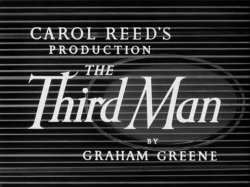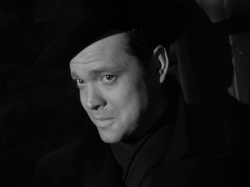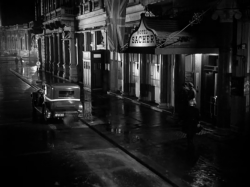by NEIL SINYARD
Introduction
Despite winning the Bronze Golden Bear at the 1953 Berlin Film Festival and being a Grand Prix nominee at the Cannes Festival of the same year, the UK/Swiss co-production, The Village has attracted little attention since its first showings. To say it has over been overlooked would be an understatement: you would struggle to find a single reference to the film, let alone a review, in any published history of British, European and World cinema. The only available online review is a negative one from Bosley Crowther in the New York Times at the time of the film’s US opening.1
This neglect is surprising, bordering on the inexplicable. After all, its technical credentials are impressive; and without mentioning The Village explicitly, one of the earliest of film historians, Paul Rotha, reckoned the team of producer, director and writer who were primarily responsible for it were “an underestimated European team that deserve more attention”.2 Moreover its basic theme – about the treatment and resettlement of displaced persons whose lives and homes have been devastated by war – was a continuation of the team’s earlier work.
The Pestalozzi Project
The film is dedicated to the teachers and children of Pestalozzi village in the Swiss Alps. Although it points out in the opening prologue that this is a story and not a history, it is clearly intended as a tribute to the values of international understanding that the village espoused. It was named after a Swiss humanitarian and social reformer, Johann Heinrich Pestalozzi (1746-1827), who had dedicated most of his adult life in endeavouring to secure educational provision for the poor, the underprivileged, and those without any family support. He believed in “learning by hand, head, and heart”, which became a sort of mantra; and his subsequent influence on educational content and reform was huge. In 1947 the Swiss philosopher, Dr Walter Corti, had created a children’s village named after him and as a memorial to his ideals, and which accommodated around 200 children from across Europe who had been orphaned during World War Two. They were housed in small national groups where they could be taught in their own languages and cultures. (It was, incidentally, a humanitarian initiative that was to expand globally over the next decade, and beyond.) The film’s task was to encapsulate the spirit of the Pestalozzi enterprise in dramatic form.

 To commemorate the 70th anniversary of the release of Carol Reed’s The Third Man and the 20th anniversary of its being voted the best British film of the century in a British Film Institute poll, I want to offer some reflections on the film and particularly on the character of Harry Lime, who, as played by Orson Welles, is assuredly one of the cinema’s most charismatic villains. A remarkable aspect of Lime’s cinematic durability is that he is only on screen for around 8 minutes or so. My focus will be on those scenes in which he appears and the reasons for their impact. To begin with, however, I wish to ruminate on one of his most striking features: his name.
To commemorate the 70th anniversary of the release of Carol Reed’s The Third Man and the 20th anniversary of its being voted the best British film of the century in a British Film Institute poll, I want to offer some reflections on the film and particularly on the character of Harry Lime, who, as played by Orson Welles, is assuredly one of the cinema’s most charismatic villains. A remarkable aspect of Lime’s cinematic durability is that he is only on screen for around 8 minutes or so. My focus will be on those scenes in which he appears and the reasons for their impact. To begin with, however, I wish to ruminate on one of his most striking features: his name. In Ways of Escape, Graham Greene mentioned some of the symbolic interpretations which had been offered about the names of the two main characters of his screenplay, Harry Lime and Holly Martins: for example, how the former had been linked to the lime tree in Sir James Frazer’s classic study of pagan mythology, The Golden Bough (1922), and how Holly was clearly associated with Christmas, so symbolically they represented a clash between paganism and Christianity. Greene could offer a much simpler explanation for what he had in mind:
In Ways of Escape, Graham Greene mentioned some of the symbolic interpretations which had been offered about the names of the two main characters of his screenplay, Harry Lime and Holly Martins: for example, how the former had been linked to the lime tree in Sir James Frazer’s classic study of pagan mythology, The Golden Bough (1922), and how Holly was clearly associated with Christmas, so symbolically they represented a clash between paganism and Christianity. Greene could offer a much simpler explanation for what he had in mind: However, it is worth noting that a character’s name in The Third Man, like his or her nationality, is a very slippery business in what is an extremely slippery film (in terms of its narrative development, its camera style, and even its streets, which seem to gleam with wetness although it never rains). Holly was originally Rollo but is sometimes called Harry by Anna Schmidt (Alida Valli), who is supposedly Austrian but is actually Czech, so one could surmise that Schmidt is not her real name.
However, it is worth noting that a character’s name in The Third Man, like his or her nationality, is a very slippery business in what is an extremely slippery film (in terms of its narrative development, its camera style, and even its streets, which seem to gleam with wetness although it never rains). Holly was originally Rollo but is sometimes called Harry by Anna Schmidt (Alida Valli), who is supposedly Austrian but is actually Czech, so one could surmise that Schmidt is not her real name.